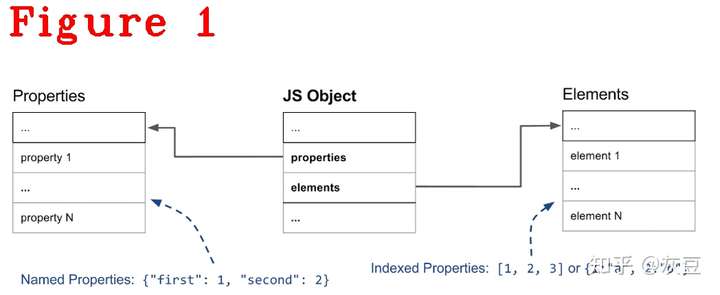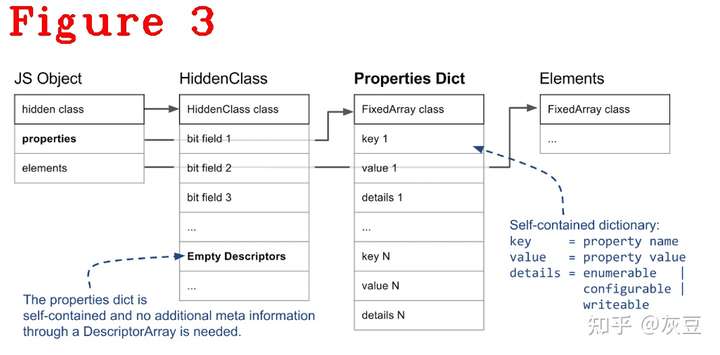

《Chrome V8原理讲解》第十七篇 JS对象的内存布局与创建过程
source link: https://zhuanlan.zhihu.com/p/431625839
Go to the source link to view the article. You can view the picture content, updated content and better typesetting reading experience. If the link is broken, please click the button below to view the snapshot at that time.

《Chrome V8原理讲解》第十七篇 JS对象的内存布局与创建过程
《javascript高级程序设计》中对JS对象有这样的描述:“ECMA-262 将对象定义为一组属性的无序集合。严格来说,这意味着对象就是一组没有特定顺序的值。对象的每个属性或方法都由一个名称来标识,这个名称映射到一个值。可以把ECMAScript的对象想象成一张散列表,其中的内容就是一组名/值对,值可以是数据或者函数。”v8官方文档提到这样的描述:“出于性能、亦或代码设计的考虑,V8中对数据类型的设计做了详细分类,对JS对象内部的数据成员也做了不同的设计”。
本文深入V8内部,详细剖析JS对象的创建过程,讲解JS对象内部成员的组成方式、内存布局,以及重要数据结构。本文内容组织方式:V8中JS对象的重要概念、成员组成和内存布局(章节2);JS对象创建过程(章节3)。
2 JS对象
在V8中,JS对象的每个成员、方法都有详细的分类和内存组织规则,内部成员从数据类型看分为两大类,元素类(Element)和属性类(Property),如图1。

图1(来自V8官方)中,可以看到元素和属性分开存储,原因是为提高效率。Element成员可以利用下标访问,它存在连续的地址空间中。Property成员,也是存在连的地址空间中,但不能使用下标访问成员,需要借助Map(HiddenClass)访问,Map记载了数据的描述符,通俗地说,Map描述数据的形状,数据访问方式等,参见第十四篇文章。元素类数据不需要借助Map,他的访问效率要高一些,如图2。

图2(出处同图1)中,除了Element和Property之外,还有In-object property,它与前面提到的Property不同之处是访问时不需要借助Map,这提高了访问效率,但In-object property的数量有限,优先使用In-object property,用完之后使用前面提到的“正常”Property进行存储。

图3(出处同图1),JS对象成员的访问方式有三种:
(1) In-Object,JS对象负责维护地址,它直接存在JS对象中;
(2) Slow方式,需要借助Map访问其成员;
(3) Self-dict,JS对象自己维护地址,不需要借助Map,采用字典方式存储数据。
self-dict是效率最差的存储方式,当数据很多并且不连续时,V8会放弃Map机制,改用self-dict方式存储。
图4给出了JS对象的内存部局。
申请JS对象时,对象的首地址指向Map(Map大小为:80byte),存在多个JS对象共用同一Map的情况,对象中还包括了Property back store和Element back store指针,是否包含其它成员依据情况而定,稍后见代码解释。
JS对象的成员方法存在哪里?文章开头处提到:它是普通的Property成员。通过下面的测试代码解释成员方法的存储方式。
1. function person(name) {
2. this.name=name;
3. this.sayname=function(){console.log(this.name);}
4. }
5. worker = new person("Nicholas");
6. worker.sayname();
7. //分隔线..............................................................
8. //分隔线..............................................................
9. Bytecode Age: 0
10. 000001DAA2FA1E96 @ 0 : 13 00 LdaConstant [0]
11. 000001DAA2FA1E98 @ 2 : c2 Star1
12. 000001DAA2FA1E99 @ 3 : 19 fe f8 Mov <closure>, r2
13. 0 E> 000001DAA2FA1E9C @ 6 : 64 51 01 f9 02 CallRuntime [DeclareGlobals], r1-r2
14. 100 S> 000001DAA2FA1EA1 @ 11 : 21 01 00 LdaGlobal [1], [0]
15. 000001DAA2FA1EA4 @ 14 : c2 Star1
16. 000001DAA2FA1EA5 @ 15 : 13 02 LdaConstant [2]
17. 000001DAA2FA1EA7 @ 17 : c1 Star2
18. 000001DAA2FA1EA8 @ 18 : 0b f9 Ldar r1
19. 109 E> 000001DAA2FA1EAA @ 20 : 68 f9 f8 01 02 Construct r1, r2-r2, [2]
20. 107 E> 000001DAA2FA1EAF @ 25 : 23 03 04 StaGlobal [3], [4]
21. 134 S> 000001DAA2FA1EB2 @ 28 : 21 03 06 LdaGlobal [3], [6]
22. 000001DAA2FA1EB5 @ 31 : c1 Star2
23. 141 E> 000001DAA2FA1EB6 @ 32 : 2d f8 04 08 LdaNamedProperty r2, [4], [8]
24. 000001DAA2FA1EBA @ 36 : c2 Star1
25. 141 E> 000001DAA2FA1EBB @ 37 : 5c f9 f8 0a CallProperty0 r1, r2, [10]
26. 000001DAA2FA1EBF @ 41 : c3 Star0
27. 151 S> 000001DAA2FA1EC0 @ 42 : a8 Return
28. Constant pool (size = 5)
29. 000001DAA2FA1E29: [FixedArray] in OldSpace
30. - map: 0x024008ac12c1 <Map>
31. - length: 5
32. 0: 0x01daa2fa1d11 <FixedArray[2]>
33. 1: 0x01daa2fa1c09 <String[6]: #person>
34. 2: 0x01daa2fa1c39 <String[8]: #Nicholas>
35. 3: 0x01daa2fa1c21 <String[6]: #worker>
36. 4: 0x01daa2fa1c51 <String[7]: #sayname>
上半部分是js源码,下半部分是Bytecode。代码19行Construct构建JS对象person,并传递参数Nicholas,代码16,17行从常量池中取出Nicholas并存储到r2寄存器。而sayname成员是一个方法,因为lazy编译的原因,此时不做编译,而是在代码6行执行时才做编译,如下给出sayname成员编译后的字节码:
Bytecode Age: 0
29 S> 000001DAA2FA21AE @ 0 : 0b 03 Ldar a0
38 E> 000001DAA2FA21B0 @ 2 : 32 02 00 00 StaNamedProperty <this>, [0], [0]
47 S> 000001DAA2FA21B4 @ 6 : 7f 01 00 01 CreateClosure [1], [0], #1
59 E> 000001DAA2FA21B8 @ 10 : 32 02 02 02 StaNamedProperty <this>, [2], [2]
000001DAA2FA21BC @ 14 : 0e LdaUndefined
97 S> 000001DAA2FA21BD @ 15 : a8 Return
Constant pool (size = 3)
000001DAA2FA2151: [FixedArray] in OldSpace
- map: 0x024008ac12c1 <Map>
- length: 3
0: 0x024008ac5379 <String[4]: #name>
1: 0x01daa2fa20f9 <SharedFunctionInfo sayname>
2: 0x01daa2fa1c51 <String[7]: #sayname>
在上面的字节码中,看不到console.log,因为在此阶段V8仅执行sayname,虽然我们知道sayname的主体功能只有console.log,但V8还没有执行它,所以不编译。不执行时不编译,这就是lazy思想。
上述代码可以看出:sayname虽然是一个成员方法,但在JS对象内部,它只是普通的Property成员。
3 JS对象的创建过程
使用上面的测试用例,下面是创建person对象的源码位置:
1. RUNTIME_FUNCTION(Runtime_NewObject) {
2. HandleScope scope(isolate);
3. DCHECK_EQ(2, args.length());
4. CONVERT_ARG_HANDLE_CHECKED(JSFunction, target, 0);
5. CONVERT_ARG_HANDLE_CHECKED(JSReceiver, new_target, 1);
6. RETURN_RESULT_OR_FAILURE(
7. isolate,
8. JSObject::New(target, new_target, Handle<AllocationSite>::null()));
9. }
10. //分隔线.....................................
11. MaybeHandle<JSObject> JSObject::New(Handle<JSFunction> constructor,
12. Handle<JSReceiver> new_target,
13. Handle<AllocationSite> site) {
14. Isolate* const isolate = constructor->GetIsolate();
15. DCHECK(constructor->IsConstructor());
16. DCHECK(new_target->IsConstructor());
17. DCHECK(!constructor->has_initial_map() ||
18. !InstanceTypeChecker::IsJSFunction(
19. constructor->initial_map().instance_type()));
20. Handle<Map> initial_map;
21. ASSIGN_RETURN_ON_EXCEPTION(
22. isolate, initial_map,
23. JSFunction::GetDerivedMap(isolate, constructor, new_target), JSObject);
24. int initial_capacity = V8_ENABLE_SWISS_NAME_DICTIONARY_BOOL
25. ? SwissNameDictionary::kInitialCapacity
26. : NameDictionary::kInitialCapacity;
27. Handle<JSObject> result = isolate->factory()->NewFastOrSlowJSObjectFromMap(
28. initial_map, initial_capacity, AllocationType::kYoung, site);
29. isolate->counters()->constructed_objects()->Increment();
30. isolate->counters()->constructed_objects_runtime()->Increment();
31. return result;
32. }创建过程由RUNTIME_FUNCTION(Runtime_NewObject)开始,它是一个宏模板,在上篇文章中讲过,本文不在赘述。JSObject::New()方法新建JS对象,进入JSFunction::GetDerivedMap(isolate, constructor, new_target), JSObject);方法,源码如下:
1. MaybeHandle<Map> JSFunction::GetDerivedMap(Isolate* isolate,
2. Handle<JSFunction> constructor,
3. Handle<JSReceiver> new_target) {
4. EnsureHasInitialMap(constructor);
5. Handle<Map> constructor_initial_map(constructor->initial_map(), isolate);
6. if (*new_target == *constructor) return constructor_initial_map;
7. Handle<Map> result_map;
8. if (new_target->IsJSFunction()) {
9. Handle<JSFunction> function = Handle<JSFunction>::cast(new_target);
10. if (FastInitializeDerivedMap(isolate, function, constructor,
11. constructor_initial_map)) {
12. return handle(function->initial_map(), isolate);
13. }
14. }
15. Handle<Object> prototype;
16. if (new_target->IsJSFunction()) {
17. Handle<JSFunction> function = Handle<JSFunction>::cast(new_target);
18. if (function->has_prototype_slot()) {
19. // Make sure the new.target.prototype is cached.
20. EnsureHasInitialMap(function);
21. prototype = handle(function->prototype(), isolate);
22. } else {
23. // No prototype property, use the intrinsict default proto further down.
24. prototype = isolate->factory()->undefined_value();
25. }
26. } else {
27. //省略很多..............
28. }
29. if (!prototype->IsJSReceiver()) {
30. //省略很多..............
31. }
32. Handle<Map> map = Map::CopyInitialMap(isolate, constructor_initial_map);
33. map->set_new_target_is_base(false);
34. CHECK(prototype->IsJSReceiver());
35. if (map->prototype() != *prototype)
36. Map::SetPrototype(isolate, map, Handle<HeapObject>::cast(prototype));
37. map->SetConstructor(*constructor);
38. return map;
39. }Handle<JSFunction> constructor是构造函数person(测试代码),代码16行时构造函数的Map基本完成,这里设置并安装prototype。代码4行,EnsureHasInitialMap(constructor);很重要,它的作用是计算构造函数constructor的形状并生成Map。然后使用这个Map申请内存、创建对象的实例worker(测试样例代码),计算过程需要对它进行编译(如果之前没有编译过),代码如下:
1. void JSFunction::EnsureHasInitialMap(Handle<JSFunction> function) {
2. DCHECK(function->has_prototype_slot());
3. DCHECK(function->IsConstructor() ||
4. IsResumableFunction(function->shared().kind()));
5. if (function->has_initial_map()) return;
6. Isolate* isolate = function->GetIsolate();
7. int expected_nof_properties =
8. CalculateExpectedNofProperties(isolate, function);
9. if (function->has_initial_map()) return;
10. InstanceType instance_type;
11. if (IsResumableFunction(function->shared().kind())) {
12. instance_type = IsAsyncGeneratorFunction(function->shared().kind())
13. ? JS_ASYNC_GENERATOR_OBJECT_TYPE
14. : JS_GENERATOR_OBJECT_TYPE;
15. } else {
16. instance_type = JS_OBJECT_TYPE;
17. }
18. int instance_size;
19. int inobject_properties;
20. CalculateInstanceSizeHelper(instance_type, false, 0, expected_nof_properties,
21. &instance_size, &inobject_properties);
22. Handle<Map> map = isolate->factory()->NewMap(instance_type, instance_size,
23. TERMINAL_FAST_ELEMENTS_KIND,
24. inobject_properties);
25. Handle<HeapObject> prototype;
26. if (function->has_instance_prototype()) {
27. prototype = handle(function->instance_prototype(), isolate);
28. } else {
29. prototype = isolate->factory()->NewFunctionPrototype(function);
30. }
31. DCHECK(map->has_fast_object_elements());
32. DCHECK(prototype->IsJSReceiver());
33. JSFunction::SetInitialMap(isolate, function, map, prototype);
34. map->StartInobjectSlackTracking();
35. }代码5行,如果已经有Map,不用再计算了,返回。代码7行,计算构造函数的属性值,这里进行编译。代26~30行,生成prototype(注意区分:这里是生成,然后才是前面提到的设置和安全),构造函数是第一次生成,没有prototype,进入代码29行。注意: 这里可以看出,同一个构函数的不同实例之间是共用一个prototype,因为prototype设置在构造函数person上,我们用person实例多个对象时,只有在person初次生成时才执行代码29行。
再来看代码7行,源码如下:
1. int JSFunction::CalculateExpectedNofProperties(Isolate* isolate,
2. Handle<JSFunction> function) {
3. int expected_nof_properties = 0;
4. for (PrototypeIterator iter(isolate, function, kStartAtReceiver);
5. !iter.IsAtEnd(); iter.Advance()) {
6. Handle<JSReceiver> current =
7. PrototypeIterator::GetCurrent<JSReceiver>(iter);
8. if (!current->IsJSFunction()) break;
9. Handle<JSFunction> func = Handle<JSFunction>::cast(current);
10. Handle<SharedFunctionInfo> shared(func->shared(), isolate);
11. IsCompiledScope is_compiled_scope(shared->is_compiled_scope(isolate));
12. if (is_compiled_scope.is_compiled() ||
13. Compiler::Compile(isolate, func, Compiler::CLEAR_EXCEPTION,
14. &is_compiled_scope)) {
15. DCHECK(shared->is_compiled());
16. int count = shared->expected_nof_properties();
17. if (expected_nof_properties <= JSObject::kMaxInObjectProperties - count) {
18. expected_nof_properties += count;
19. } else {
20. return JSObject::kMaxInObjectProperties;
21. }
22. } else {
23. continue;
24. }
25. }
26. if (expected_nof_properties > 0) {
27. expected_nof_properties += 8;
28. if (expected_nof_properties > JSObject::kMaxInObjectProperties) {
29. expected_nof_properties = JSObject::kMaxInObjectProperties;
30. }
31. }
32. return expected_nof_properties;
33. }Handle<JSFunction> function是构造函数person,代码13行进行编译并计算对象的属性值数量。代码28行,会与MaxInObject比较,如果大于MaxInObject,那么属性值数量就是MaxInObject。前面提到JS对象中In-Object数量有限,MaxInObject正是它的最大数量。多出的属性值在后面会作处理——放入图1的属性值存储区。
回到JSObject::New()方法中代码27行,用Map去申请JS对象的内存,后面就是对象实例化的参数设置等等,请读者根据图5的函数堆栈自行跟踪。
好了,今天到这里,下次见。
恳请读者批评指正、提出宝贵意见
微信:qq9123013 备注:v8交流 邮箱:[email protected]
本文由灰豆原创发布
Recommend
About Joyk
Aggregate valuable and interesting links.
Joyk means Joy of geeK